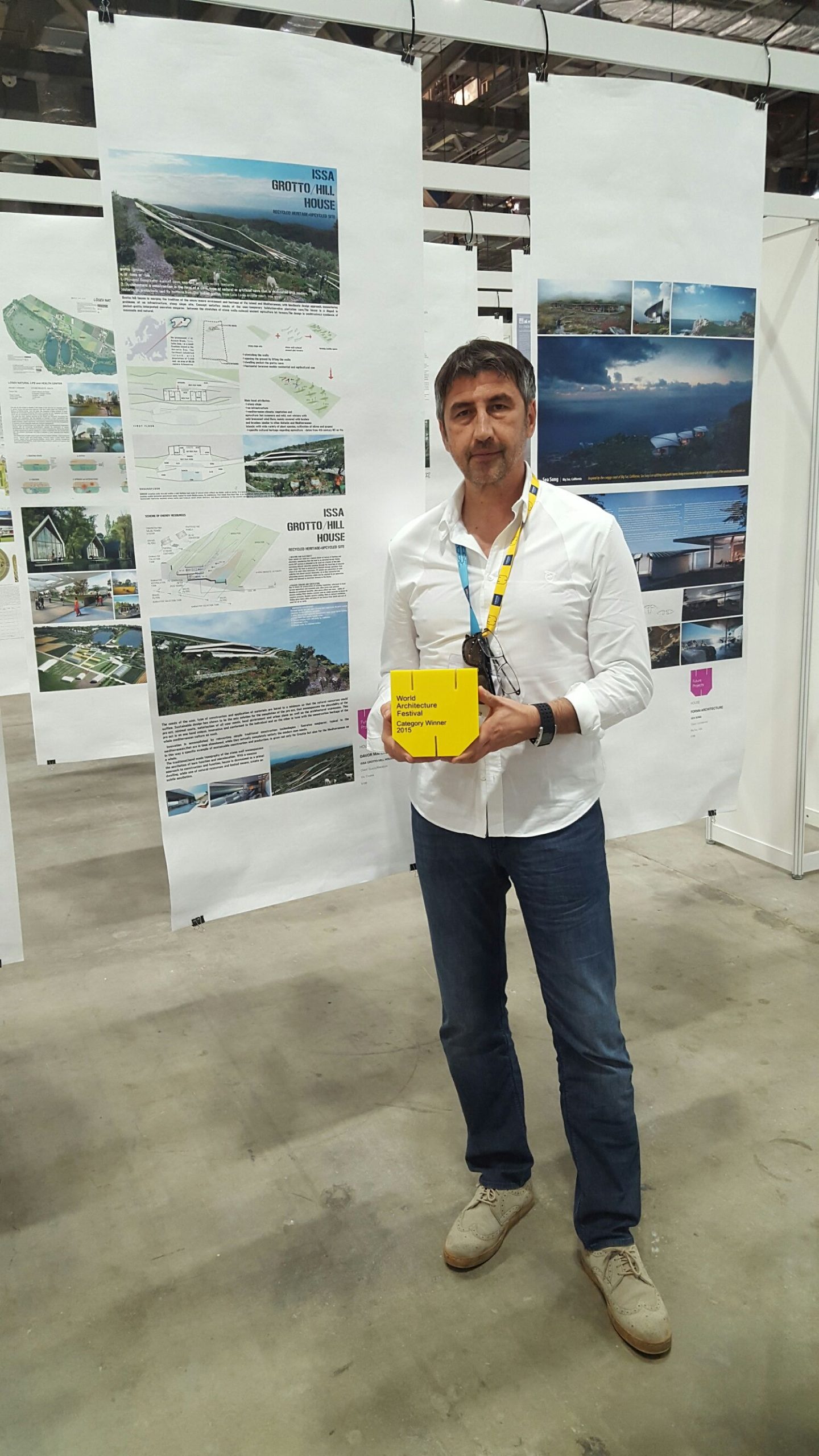Interview with Davor Mateković from PROARH Studio
Coming from Dalmatia, a part of Croatia where building a house usually means either something that can fit 3 generations or a house that includes at least three rental apartments for tourists, I was more than pleasantly surprised to see that a Croatian architectural studio won a gold medal for a project that is going to be located on island Vis. Finally, a bit of futurism instead of concrete monstrosities we are used to around here.
PROARH studio from Zagreb just returned from the World Architecture Festival, which was held in Singapore early November 2015, with the top award in their hands in the category “House – future projects”, beating architectural giants such as Herzog de Meuron, Spark, BIG , Foster & Partners, OMA, Zaha Hadid, Grimshaw, Vinoly and many others.
They won the award for their innovative futuristic project „Issa Grotto Hill House“, and here’s what the co-founder and lead designer of PROARH Davor Mateković had to say to our colleague Leo Nikolić from T-Portal who kindly allowed us to translate and share his interview.

The wonder of futuristic architecture on island Vis by Leo Nikolić
(Photos copyright by PROARH, thank you Vedrana for allowing us to use them)
World Architecture Festival is a prestigious event and an overview of the current trends in global architecture. This year, in its 8th edition, one Croatian project was among the 27 winners in various categories. Project developed by PROARH studio from Zagreb won the top accolade for its „Issa Grotto Hill House“, designed by Davor Mateković in the category „House – future projects“.
This kind of an award at one of the most important international architecture events might come as a surprise to the general public, but not to those who are familiar with the work of Davor Mateković and PROARH. This award is icing on the cake for his exceptional work and forward thinking in architecture which involves great respect for tradition, ecology, functionality and sustainability. It also includes sensible use of all available modern technologies in civil engineering.
Vis project is still in its development stage, full realisation is expected next year, Davor Mateković told us. „Issa Grotto House“ will be located on the southern slopes of Vis on a 7 000 m2 land plot. It is almost completely energy autonomous, using solar energy and rain water for the needs of its inhabitants and for the irrigation of olive groves that will surround it. Land plot is on a sloped terrain with traditional Dalmatian dry stone walls. The basic idea of the architect was to honour the „villa rustica“ form, and to construct it using the dry stone wall technique and harmoniously overlapping all objects so they follow the natural land configuration.

The house is completely immersed in its Mediterranean surroundings and offers exceptional living standard and quality. The name of the project „Issa Grotto Hill House“ is in no way accidental and it clearly refers to the roots of the oldest town on the Eastern shores of the Adriatic, the Greek Issa, dating back to antiquity. Name of the project also evokes the archaic, sustainable lifestyle in tune with nature but the object itself represents a leap into modernity while still respecting tradition and time old knowledge.

Few months ago, another house by Mateković, „Matera“ in Poreč, won the annual Cemex award and the futuristic project in Vis is the continuation of his earlier projects „Stone House“ in Lukovo Šugarje, house in Tisno, „Hiža“ in Kumrovec and the „Bivak“ family house project in Zagorje. In all of these projects he uses traditional techniques and materials (wood, stone, straw), depending on each geographical location, local specifics and modern interpretation. These houses are not necessarily hostages to the dominant trend of energy efficiency and sustainability; instead, they meet high contemporary living and functionality standards, which is often not the case in similar projects.
„Specifics of every individual project are both an inspiration and a „burden“ which the house must carry. This particular project is in a specific location and on a very specific land plot – we are building in the very centre of island Vis, on a plot with no infrastructure, on a large slope, surrounded by thick macchia, untouched Mediterranean which makes this island what it is. These elements, especially the legacy of dry stone walls, its function and aesthetics, were the main idea behind the Issa Grotto House“ – Mateković commented on the inspiration behind his award winning project.
How important is the balance between tradition and sustainability and modern living standards?
It is very important, especially when it comes to living spaces, its primary function must be flawlessly resolved. All other elements that enrich it have to be in perfect balance. Tradition, or our architectural heritage and technology of sustainability are the core values of this house, they give it exceptional character, but they are in no way primary. Comfortable living within this space is achieved through the addition of all the perks of modern life, we did not hold back on those, because to live in harmony with the spirit of the space you’re in should never mean you have to suspend the spirit of the time we’re living in – Mateković added.

Can Croatian architects turn around the degradation trend on our coast?
„The degradation trend you’re referring to is not really a trend. Because a trend is momentary and this degradation has been taking place for over half a century. Over time, summer houses and whole „Zimmer frei“settlements became a part of our folklore. Croatian architectural scene is potent on a global scale and it was just as good 50 years ago. This is why we have some exceptional creations along the coast from tourist villages to small objects and houses that are 45, 15 and 5 years old. The problem is, they’re in minority and while we are lead by some other interests, our coast will be full of hacienda type houses, Corinthian poles and Tuscan villas. This doesn’t mean we have to replicate the Istrian kažun and old stone houses to infinity, but we have to understand architecture and our architectural heritage. Without it, there will be no improvement, and this improvement is not the task of just one generation, the idea that something can change in an instant is just not realistic“Mateković states.
Urban planning failed miserably in Croatia over the last three decades. Politics just can’t seem to correct the spatial mess and total disregard for public interest. Do we need a regional or national architectural – urban planning institution with necessary power to finally bring some order?
We already have institutions, both industry and legislative ones. As for politics, it could never act as a corrective for itself. This spatial mess you’re mentioning is a result of public interest no longer being anyone’s interest. One or ten more institutions are not the solution, the solution is to change our collective mindsets and actions / reactions of individuals – architects, clients and legislators – says Mateković.
New engineering and robot technologies are dictating our everyday life, and pretty soon we’ll have sustainable living „machines“. How do architects keep up with new advancements?
Architecture has always been closely connected to new technologies. Today, changes are occurring more rapidly than ever, in construction technologies, materials, equipment, general networking. Foundations of all this should be researched right from the start, so young architects could develop and have in mind the broad spectrum of interest needed to be competitive and to achieve the quality that is expected of them.
Are our Universities of Architecture following the rhythm of available technology?
You’ll have to ask them, however, just like in any other aspect of life, most of your knowledge comes from practical work, individual research and cooperation with experts from other industries and other fields of interest – Mateković concluded.









